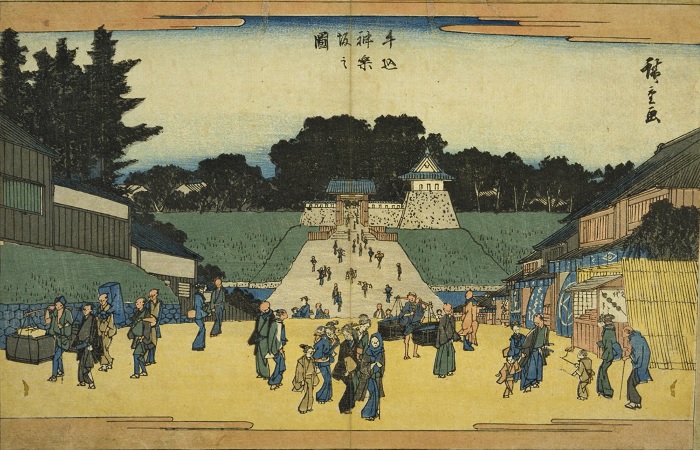外郭の概要~Overview of Gaikaku
江戸城の外郭は、外堀に囲まれた区域であり、その外周は約16kmあり、市街地をも含んでいました。見附と呼ばれる大型の門と橋が、約50セット堀と主要街道の交差点に置かれていて、民衆と交通を監視していました。これらの施設は明治維新後にほとんど撤去されてしまいます。そのためほとんどの人たちは東京に城があったことなど気付きません。それでは、東京にある外郭の痕跡を巡ってみましょう。
The outline of Edo Castle called Gaikaku was the surrounding area from the outer moat whose perimeter was about 16 km, including even the city area. About 50 sets of large gates and bridges called Mitsuke were placed at the intersections of the moat and major roads to check people and transportation. These facilities were mostly demolished after the Meiji Restoration. So most people don’t realize there was a castle in Tokyo. Then, let me introduce the traces of Gaikaku in Tokyo.
隅田川エリア~Sumida-gawa River Area
江戸時代の初め、隅田川は外堀の一部として認識されていました。そのため幕府は、日光街道上の千住大橋を除いて、この川に橋を架けることを禁じていました。1657年の明暦大火の後は、江戸の安全確保と都市化のため、他の橋も架けられるようになりました。
At the beginning of the Edo Period, Sumida-gawa River was regarded as part of the outer moats. Because of it, the Shogunate banned bridges from being built on the river excluding Senju-Ohashi Bridge on Nikko Road. After the great fire of Meireki in 1657, more bridges were built on the river for the increase of safety and urbanization of Edo City.
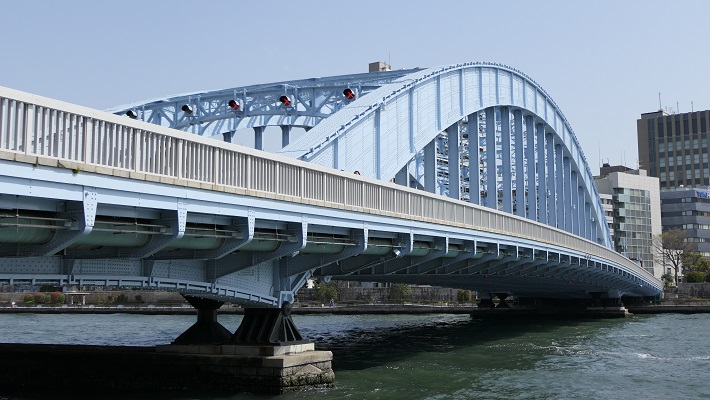
永代橋~Eitai-bashi Bridge:
隅田川に架けられた4番目の橋です。現在の橋は、1923年の関東大震災の火災により失われた後、1926年に再建されたものです。すでにそれから100年近く経過しており、重要文化財に指定されています。
It is the forth bridge on Sumida-gawa River. The present bridge was rebuilt in 1926, after it was destroyed by the fire in the Great Kanto earthquake in 1923. It is nearly 100 years old, and has become an Important Cultural Property.

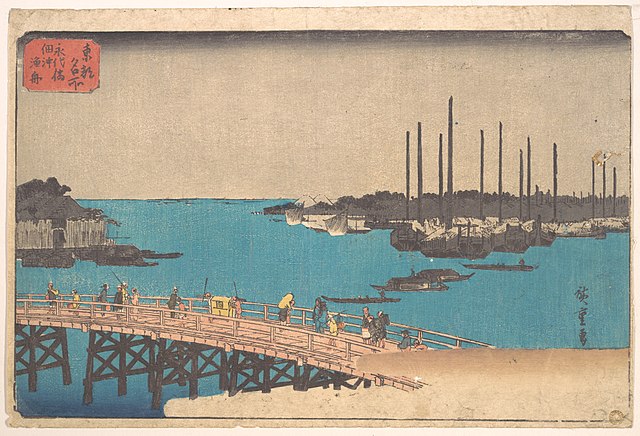
新大橋~Shin-Ohashi Bridge:
こちらは3番目に架けられた橋です。先代の橋は関東大震災を生き延びました。現在の橋は1977年に架け替えられたものです。江戸時代のこの橋は、歌川広重の有名な浮世絵に描かれたことで知られています。
It is the third bridge on the river. The former bridge survived the Great Kanto earthquake. The present one replaced it in 1977. The bridge in the Edo Period is known for being drawn in a famous Ukiyoe Painting by Hiroshige Utagawa.
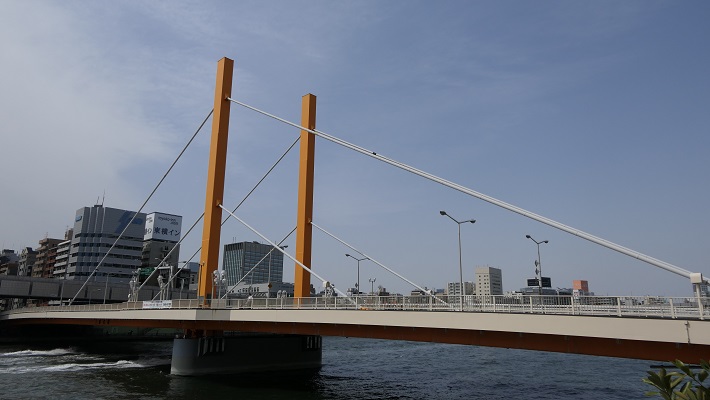

両国橋~Ryogoku-bashi Bridge:
2番目に架けられた橋です。この橋の周りは歓楽街になりました。江戸時代から夏にはこの辺で花火の催しが開かれています。近くにはまた外堀の一部である神田川の河口があります。
The second bridge on the river. The area around the bridge became a place of amusement. Fireworks displays have been also held around in the summer since the Edo Period. There is the estuary of Kanda-gawa River nearby which is another part of the outer moats.
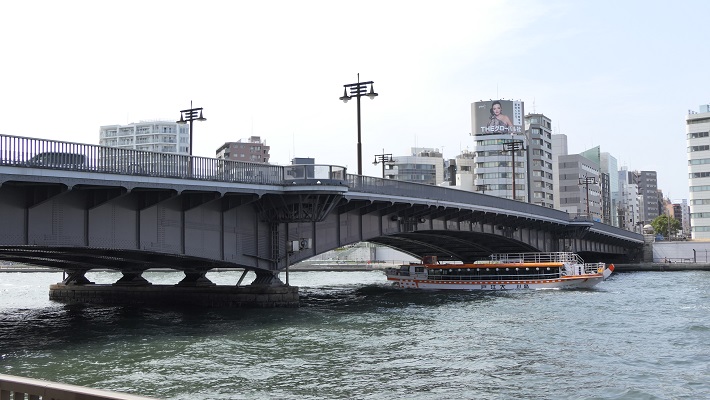

神田川エリア~Kanda-gawa River Area
「神田川」という名前は明らかに川です。ところが、この川は完全に人口物で、堀や運河として使われました。江戸時代初期に、幕府の下で伊達氏が本郷台地を掘り進んで造りだしたのです。幕府は川に沿って必要な施設を設置していました。掘削で出た残土は、下町周辺の埋め立てに使われました。
The name “Kanda-gawa” clearly shows a river (“gawa” means river.). However, the river is completely artificial, and was used as a moat and canal. In the first Edo Period, the Date clan under the Shogunate created it to cut across Hongo plateau. The Shogunate set facilities they needed along the river. The waste soil from the digging was used to reclaim the sea around downtown.
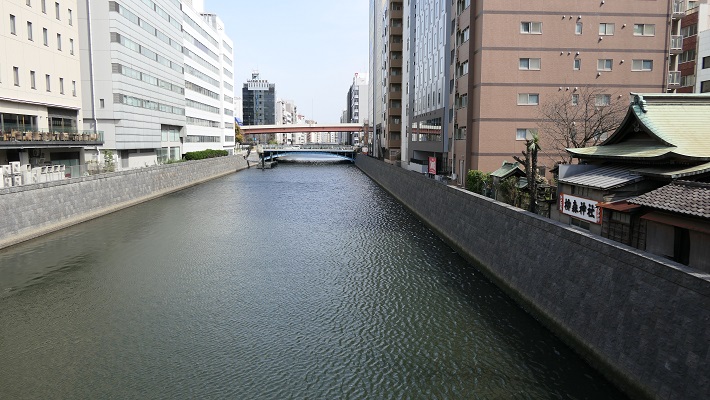
浅草橋門跡~Asakusa-bashi Gate Ruins:
この門は川と浅草を通る日光街道の交差点に築かれました。しかし明治維新後間もなく撤去されました。そのため、何らかの記念碑でもなければ、そこに何があったかはわかりません。
This gate was built at the intersection of the river and Nikko Road passing Asakusa. But it was removed soon after the Meiji Restoration, so we can’t see what was seen in the past without some kind of monument.
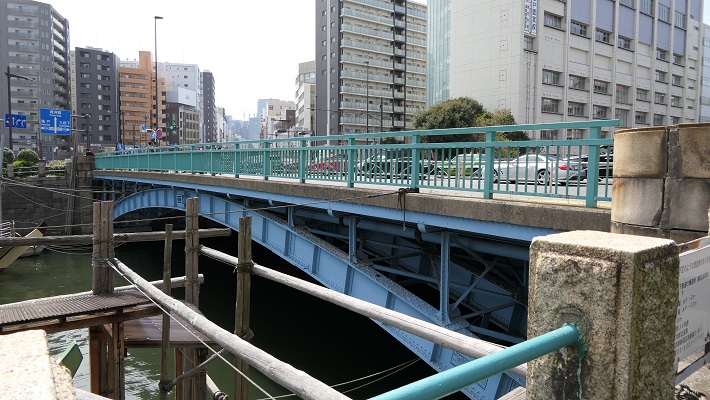
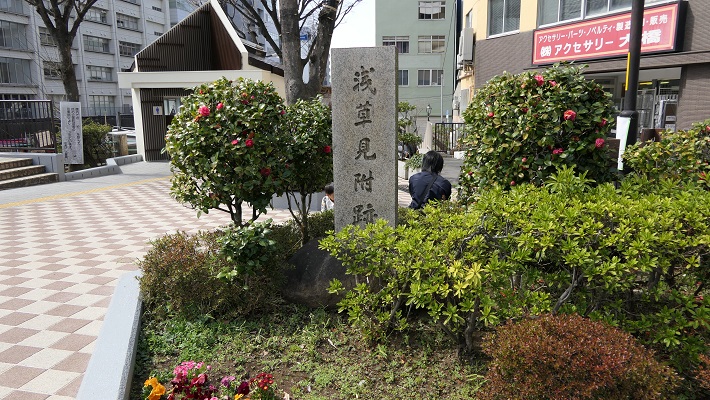

仙台堀~The Sendai Moat:
「仙台」という名前は伊達氏が仙台を拠点としていたことに由来します。JR御茶ノ水駅近くの橋からは深くえぐられた川の一部を見ることができます。JR中央線はその谷に沿って走っています。
The name “Sendai” derived of the Date clan from Sendai. You can see the part of the river being cut deeply from the bridge near JR Ocha-no-Mizu Station. JR Chuo line goes along the valley.

水道橋跡~The Water Bridge Ruins
かつて神田上水がこの水道橋によって川を横断していました。井の頭池を水源として江戸市街に給水していました。この周辺の街と、近くにある「水道橋」駅の名前はここから来ています。
Kanda water supply went across the river using the Water Bridge. It came from Inokashira Pond to feed Edo City. The names of the town around and the station nearby “Suido-bashi” comes from the bridge.
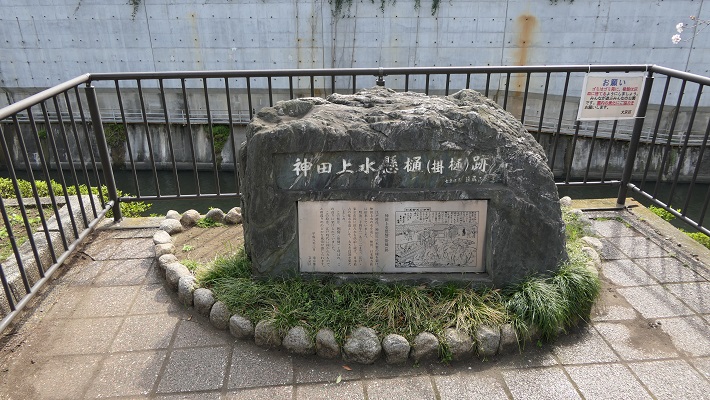


外堀の西側部分~The western part of the outer moats
この部分は1638年までに江戸城建設の総仕上げとして築かれました。自然の谷の地形を利用しています。城の中心を砲撃から守ることを意図し、堀の内側に土塁を積み上げ、外側よりも高くなるようにしています。
This part was built to finalize the construction of the Edo Castle by 1638. It used a natural valley terrain. It aimed to protect the center of the castle from a cannon attack outside by setting the inside of the moat much higher with earthen walls than the outside.
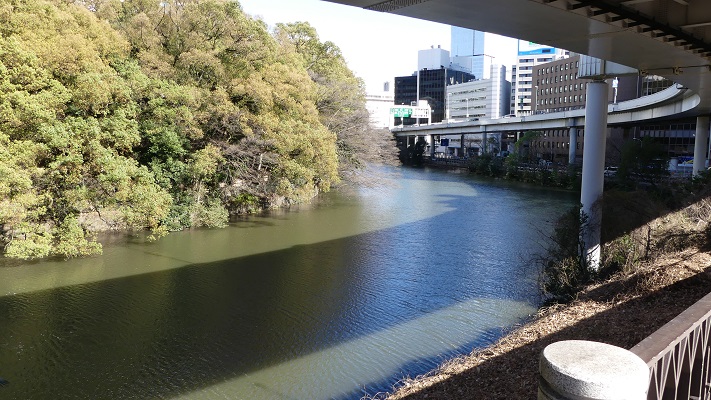
牛込門跡~Ushigome-mon Gate Ruins:
門の両側の石垣が現存しています。門跡の周辺は現在JR飯田橋駅として利用されています。門跡の反対側は神楽坂になっていて、外堀は谷底に位置しているのがわかります。牛込濠と呼ばれるその堀は、門跡の西側にほぼそのまま残っており、とても広大に見えます。
The stone walls from both sides of the gate remain. The area around the ruins are now used for JR Iida-bashi Station. The opposite of the ruins is Kagura-zaka slope, so you can see the outer moat located in the bottom of the valley. The moat called “Ushigome-bori” in the west of the ruins remain like it was, and looks very spacious.
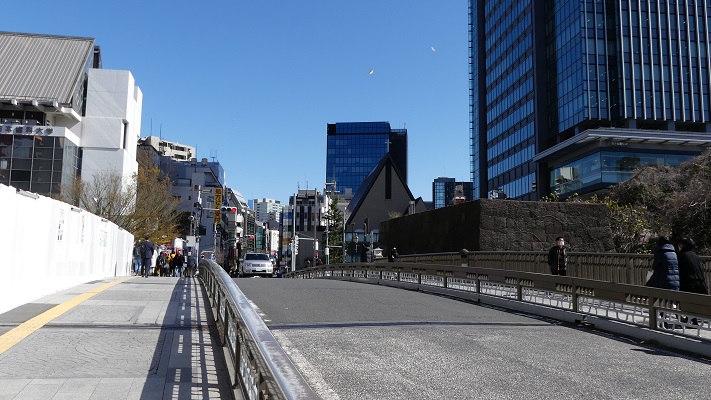
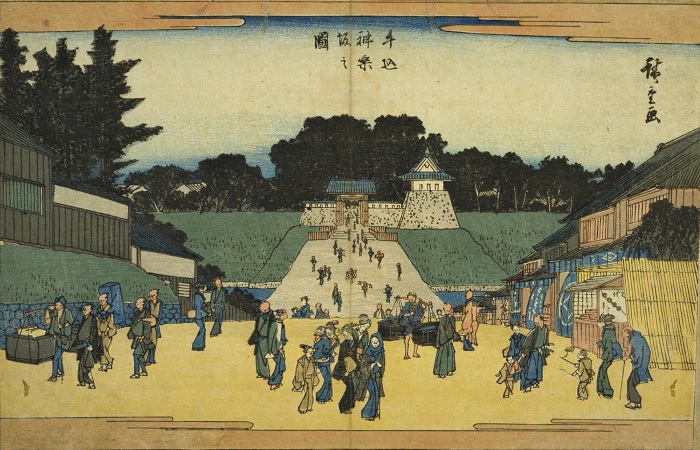
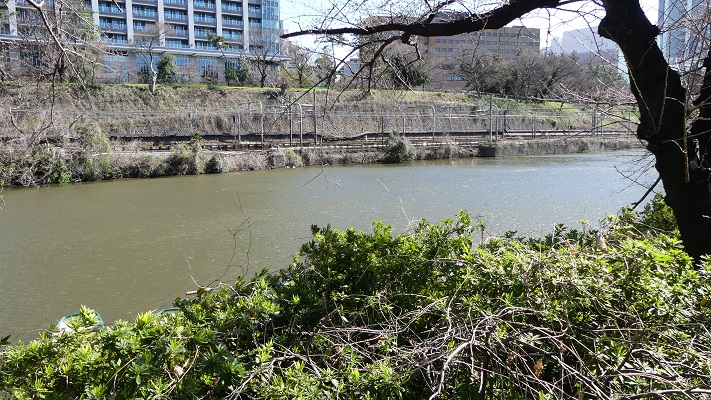
市ヶ谷門跡~Ichigaya-mon Gate Ruins:
石垣がいくらか残っており、外側から堀を渡って門に伸びる土橋も残っています。周辺はまたJR市ヶ谷駅の一部として使われています。
There are some remaining stones, and the earthen bridge from outside to the gate across the moat remains. The area around is also part of the for JR Ichigaya Station.


四谷門跡~Yotsuya-mon Gate Ruins:
門の片側の石垣が残っていますが、周辺の堀は既に埋められています。一例として、門跡西側の以前堀だったところは上智大学のグラウンドとして使われています。広大な敷地を眺めながら、内側の土塁の上を歩くことができます。
There are some remaining stone walls on one side of the gate, but outer moats around are already filled. For example, the former moat in the west of the ruins is used as the ground for Jochi University. You can walk on the inside earthen walls and enjoy a view of the spacey area.

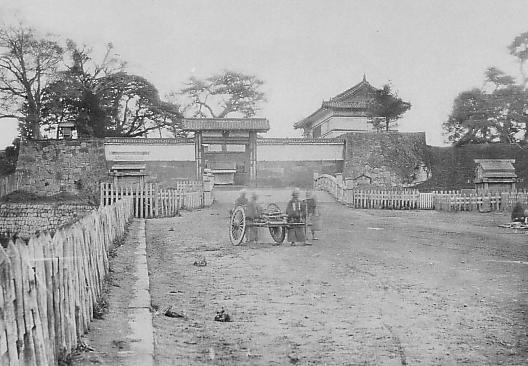
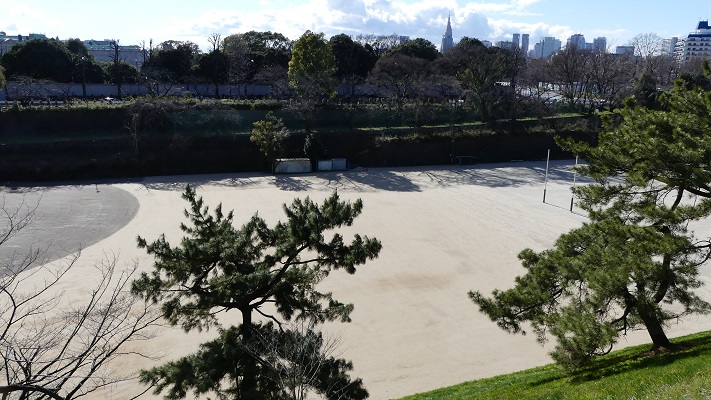
外堀が失われたエリア~The lost outer moat area
東京の都心では、いくつかの理由で外堀は既に失われています。現在では外堀通りとして自動車道になっています。過去にはどんな景観だったのか想像するのは困難です。
In the center of the Tokyo city area, the outer moat was already lost for several reasons. It is now used as the Sotobori (means onter moat) Street for automobiles. It is difficult for us to understand what can be seen in the past.
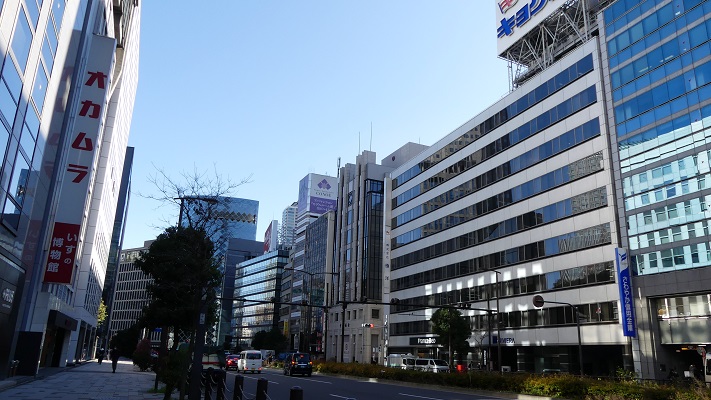
赤坂門跡~Akasaka-mon Gate Ruins:
門の石垣の一部が、赤坂見附(幕府の施設であった名前と同じ)交差点の近くに残っています。「弁慶濠」と呼ばれる現存堀が門の西側にあります。そこから続く「溜池」堀は失われています。
Part of the stone walls for the gate remain near the Akasaka Mitsuke (same as the Shogunate facility’s name) Intersection. A remaining moat called “Benkei-bori” is in the west of the gate. The following moat called “Tame-ike” has lost.
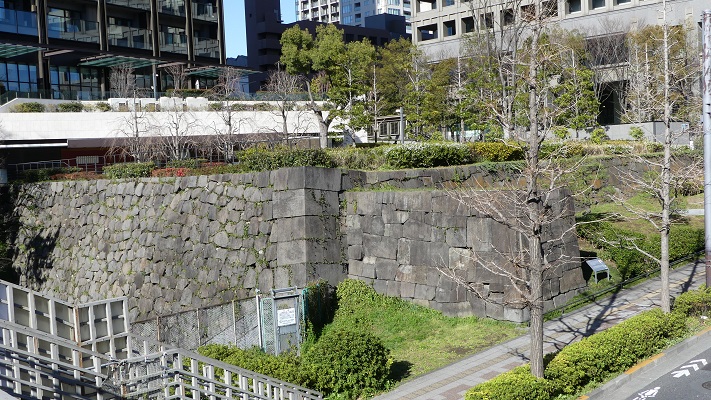
「溜池」交差点~The Tame-ike Intersection:
堀の名前が交差点の名前として残っています。溜池とは貯水池の意味です。江戸時代の初期には、江戸の人々は川をせき止め、飲料水として使っていたようです。
The name of the moat remains for the intersection. Tame-ike means reservoir. At the beginning of the Edo Period, people in Edo City seemed to dam a river, and use it for drinking water.
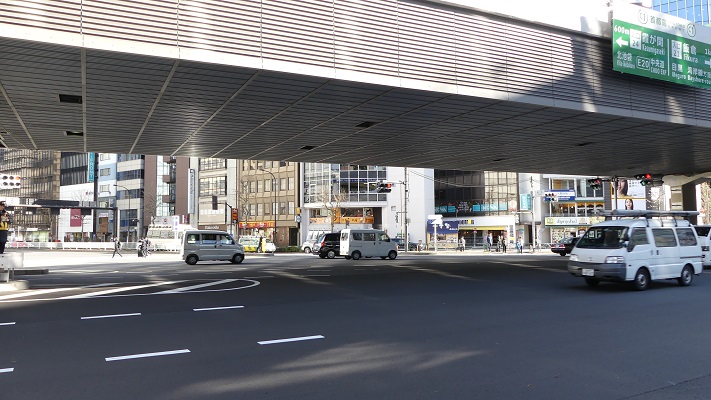
呉服橋交差点~The Gofuku-bashi Intersection:
この交差点は東京駅の近くにあります。ここには外堀と「呉服橋」という橋と呉服橋門がありました。今現在、これらの痕跡は何もありません。
The intersection is near Tokyo Station. There was an outer moat, a bridge called “Gofuku-bashi” and Gofuku-bashi Gate. They have completely removed it. We can’t see any trace of them now.


日本橋川エリア~Nihonbashi-gawa River area
ここは外堀の最後の、または最初の部分です。この箇所は江戸城の内堀の近くです。ここから外堀が市街の外側に向かって渦巻き状に伸びているので、堀を逆に辿っていくこともできます。日本橋川もまた人工川であり、元々あった川のルートを変えるために作られました。この川の上流は、平川という元あった川と同じようです。
It is the last part of the outer moats, or the first part. The part is near the inner moat of Edo Castle. We can see the outer moats spiral towards the outside of the city, so you can trace the moats backward. Nihonbashi-gawa River is also artificial and was built to change the routes of original rivers. The upper stream of the river might be the same as the original river called Hirakawa River.
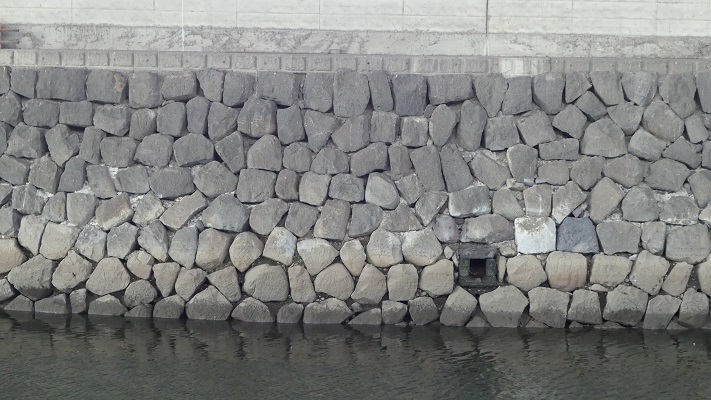
常盤橋門跡~Tokiwabashi-mon Gate Ruins:
この門の石垣がよく残っています。そのため国の史跡に指定されています。堀を渡って門に至る石橋は、明治時代に門の他の石を使って築かれたものです。近くには日本銀行旧館の建物があり、こちらは重要文化財に指定されています。
The stone walls of the gate remain well. That’s why they have been designated as a National Historic Site. The stone bridge across the moat to the gate was built using other stones from the gate in the Meiji Era. You can also see the old building for Bank of Japan nearby, designated as an Important Cultural Property.
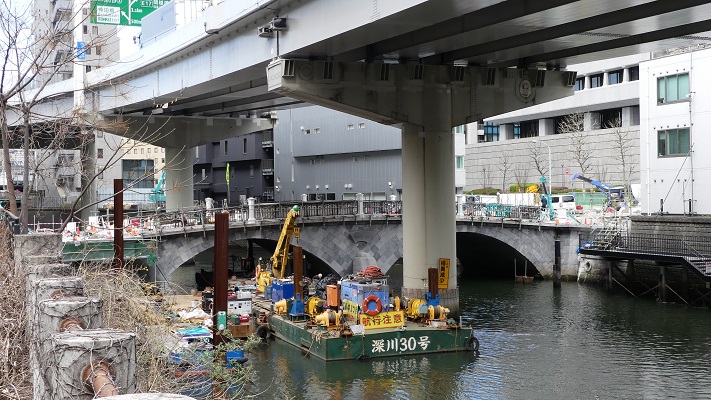
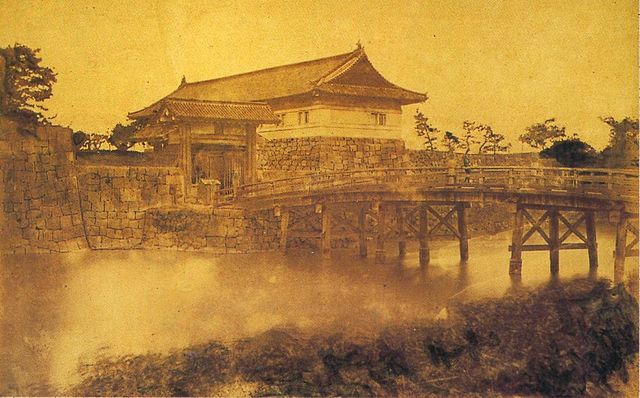

一ツ橋門跡~Hitotsubashi-mon Gate Ruins:
この門と堀周辺の石垣が残っています。江戸時代後半に、将軍の一族である一橋家の屋敷がこの門内にありました。
There are some remaining stone walls for the gate and the moat around. The hall for the Shogun’s relative called Hitotsu-bashi clan was inside the gate in the late Edo Period.

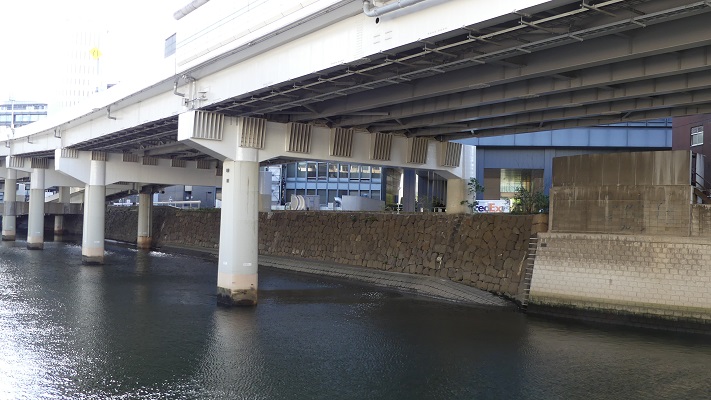
雉子橋門跡~Kijibashi-mon Gate Ruins:
ここが外堀の終点に当たります。ここから内堀が近くに見えます。日本橋川は更に上流から流れてきています。その上流を辿っていくと外堀の違う地点、小石川門の近くに到達します。実はこの上流の部分は一旦幕府によって埋められますが、明治時代になって水上交通の便ため、掘り返されました。
This is the edge of the outer moats. You can see the inner moat nearby. The river flows from a much upper area. You can follow that the upper stream and you’ll reach another spot of the outer moat near Koishi-kawa Gate. In fact, the upper stream was once filled by the Shogunate, but was dug again for water transportation in the Meiji Era.
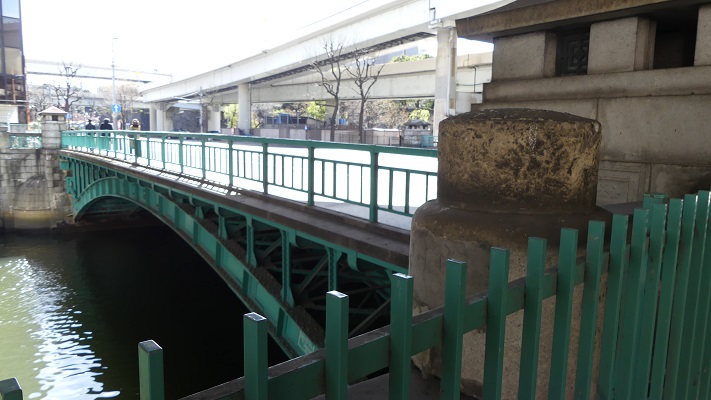
私の感想~My Impression
外堀の全てを辿ってくには1日では足りないでしょう。ですので、少しずつ部分的に訪れてみるのもよいでしょう。どちらにしても行ってみれば、江戸城はインフラ、文化、商業などの面で東京の中心につながっていることが実感できます。
It will need more than one day trip to trace all of the outer moats, so you can visit part of them one by one. Anyway, after visiting them, you can realize that Edo Castle has been the center of Tokyo in infrastructure, culture, business and so on.

リンク、参考情報~Links and References
・江戸城外堀跡、千代田区観光協会~Edo Castle outer moat trace, VISIT CHIYODA
・「江戸城の全貌/萩原さち子著」さくら舎(Japanese Book)
・「幻の江戸百年/鈴木理生著」筑摩書房(Japanese Book)
・「よみがえる日本の城2」学研(Japanese Book)
「江戸城その3」に戻ります。~Back to “Edo Castle Part3”
「江戸城その2」に戻ります。~Back to “Edo Castle Part2”
「江戸城その1」に戻ります。~Back to “Edo Castle Part1”

